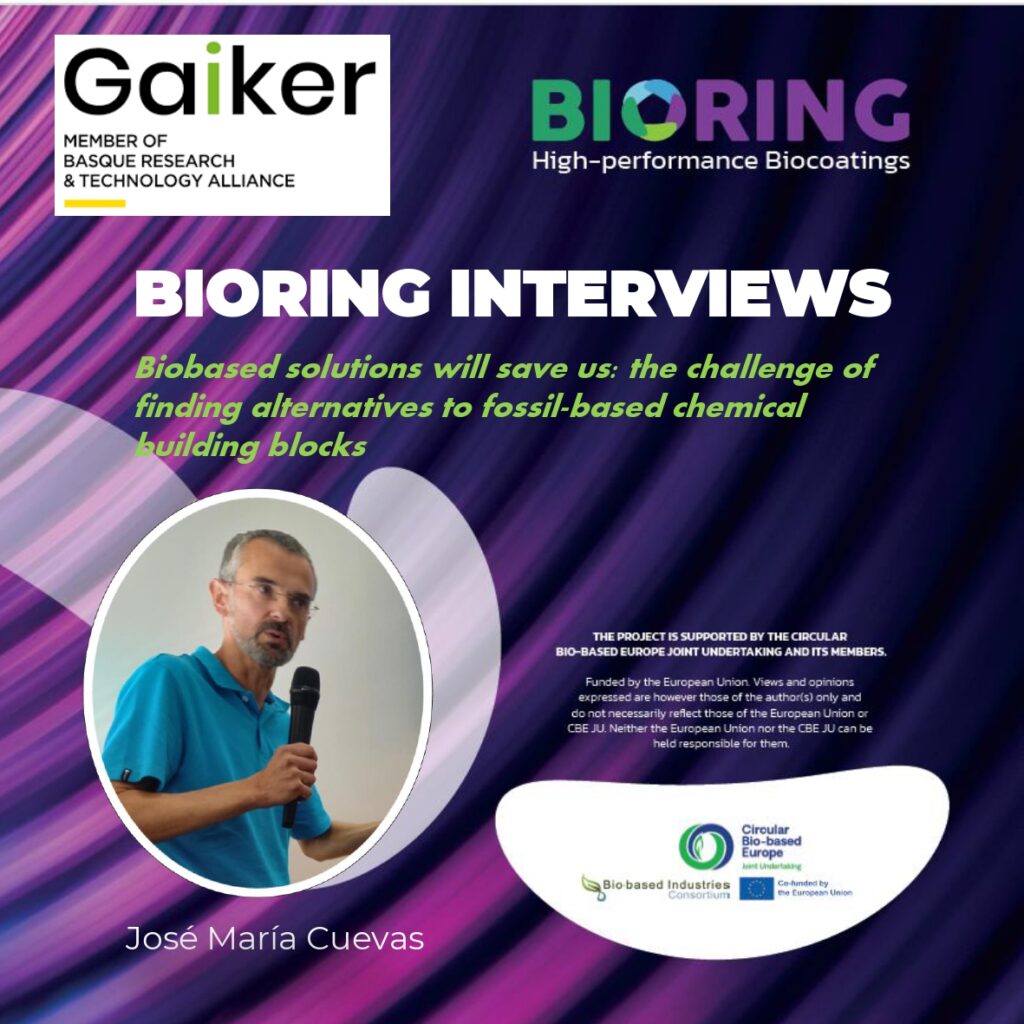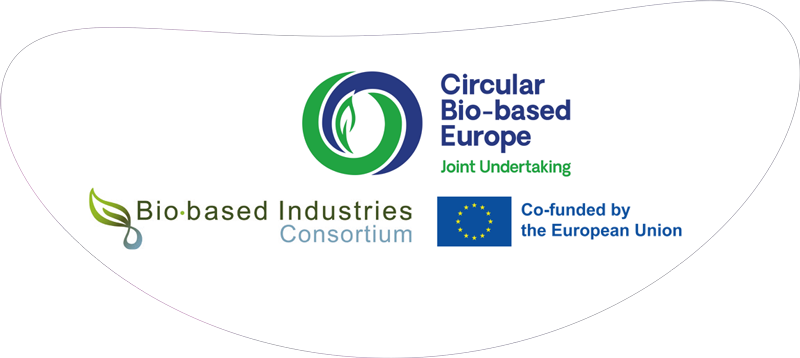Biobased solutions will save us: the challenge of finding alternatives to fossil-based chemical building blocks
Interview to José Maria Cuevas, Gaiker and BIORING Partner
(Interview made on 17th July 2024)
What is your vision about the development of the biobased sector in Europe?
Being at the forefront of research and technology and investing in biobased innovation is essential, not only to address climate change, but also to compete and remain independent in the global scene.
Europe is a relatively small region with limited natural resources, such as raw materials and energy, and biobased solutions could help. We need to be confident in our knowledge and capability, as I think we have the technologies and expertise to break the predominance of fossils-based raw materials.
Europe is a top player in coatings research, alongside with USA. Polyurethane (PU) has been invented in Europe, and we remain quite competitive in PU-coatings. We are sustaining investments in sustainability of coatings, with two main different approaches: one is to look at the overall carbon neutrality of the manufacturing cycle, the other one is to increase the bio-based content of coatings. The latter is still not cost-effective, but it is anyway less expensive for companies than covering CO2 taxes related to fossil-based production.
This is way I’m confident that European chemical companies will continue to sustain research and to develop biobased products to put on the market.
However, given a lot of R&D is still far from the market, public investments remain crucial. In my view, they are not yet sufficient, and they should be long term. EU policies in green investments are somehow unstable, both in terms of funding and topics. For example, we have seen in the past a focus on research in biodegradable or compostable solutions, then suddenly the policy goals have been changed to full recycling approaches.
Which are the most relevant barriers to develop biobased solutions?
Providing robust and reproducible chemicals from biomass in a cost-effective way is the main issue to overcome. We are now relatively good in developing biochemicals that have similar chemical structure, or anyway similar properties and characteristics, compared to petrol-based ones, but issues of quality and costs makes them, in many cases, still not competitive.
For example, lignin is quite a good raw material to develop building blocks such as phenols or polyphenols, but its homogeneity and reproducibility are problematic. And though you can create quite robust structures, these are not yet in line with industry requirements. So, you need to add extra chemical processes, increasing costs.
Nowadays, the scaling up, more than the development, is the barrier. We should consider the decades that have been used to optimize petrol-based solutions. We need time and investments to make adoption of bio-based alternatives possible. However, we also need to be aware that some products cannot be replaced, as their chemical structure does not allow to do it.
We likely also need to think about different business model, that could give more value to sustainability. It is challenging, though some sectors are doing it (e.g. food). And we need to change consumer habits, as people tend prefer the cheapest or quickest option. The problem is often not the technology itself, but how to use it, and how to drive the consumer behaviours.
Which is the novelty and added value of the BIORING process and product solutions?
Developing biobased building blocks that can work as complementary components to fossil-based ones, giving an ample flexibility to coating manufacturers in creating new protective and more sustainable coatings, is the BIORING goal. We are developing a platform that will allow up to 95% biobased contents of the coating, with composition and properties adaptable to the specific needs of the user.
Which are the breakthroughs in biobased building blocks expected by BIORING?
Our new bio-chemicals will work in smart combination with bio-chemicals already on the market, to generate new value chain of more recyclable and durable products.
In terms of raw materials, BIORING start from available compounds. We expect the market of feedstock-based chemicals to grow; bio-polyols are, for example, increasingly becoming competitive.
For the end-of-life you can look for a more compostable or a more recyclable product, as these have typically different chemical structures and properties, with weaker or stronger bonds.
In BIORING we are developing protective, resistant, and recyclable coatings, so that the coating will not be a limitation in the overall recyclability of the final coated product.
In the specific BIORING case studies (a coating for an interior component of a car, and the top layer of a laminate substrate for kitchen furniture) the most valuable factor for the customer is aesthetic. As it is just a very thin layer of coating on top of a massive substrate (some 30 microns on a 4–5-millimetre component), recyclability is thus a minor issue. However, the BIORING platform will allow to change mixture of chemicals, to reduce resistance and improve biodegradability properties of the coating (or vice versa), as this can be an added value in other sectors, such as packaging & textile.
What do you like the most and what are your expectations in participating to the BIORING project?
Increase scientific knowledge and advance our capacity to create coatings alternatives to petrol-based products, that in short-medium term will become both applicable by industry and useful to the society.
Working in a collaborative framework, instead then a competitive one, with experts coming from different areas and disciplines, such as industrial coatings, recyclability, sustainability, consumers and end-users’ perspective, and market analysis.
Trust, collaboration and knowledge sharing are the way to improve faster and better. It’s a win-win situation.
About
I’m a chemist with a background in polymers, and more than 25 years of experience in Gaiker. In the last 10 years I focused my research on coatings and their sustainability.
My aims are to develop renewable and functional chemical building blocks from biomasses, as alternatives to traditional coatings. My expertise is to provide coatings manufacturers with bio-solutions that are technically and economically efficient, and more sustainable (e.g. with lower carbon footprint).
In BIORING I’m developing and implementing the reaction processes to design and manufacture the photoreactive resin system, that is almost the 90% in composition of the overall coating formulation. My goal is to optimize curing, application and performance aspects, combining scientific and technical knowledge with end-users and markets needs and requirements.
My job is closely connected to the real world, as I’m generally working with companies, but it’s a difficult field as the market of coatings is demanding and competitive.
Gaiker is a research and technology centre, and though our goal is to work at low to medium TRLs (Technology Readiness Level), we are used to cooperate with industry and to consider their market needs and requirements. An example is the long-standing collaboration on coatings and recycling of thermoplastics with a company such Maier, a manufacturer of automotive components and coatings, that is as well a partner in the BIORING project. Companies (especially SMEs) cooperate with Gaiker to develop innovative solutions, to have specific technological services, and to get access to public research funding. EU projects are essential for Gaiker, as they help to network with other R&D players and remain updated on state-of-the-art research.


